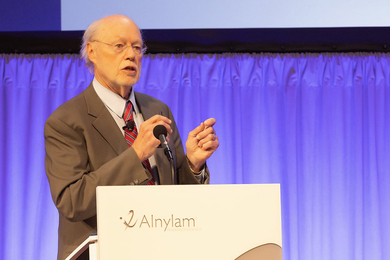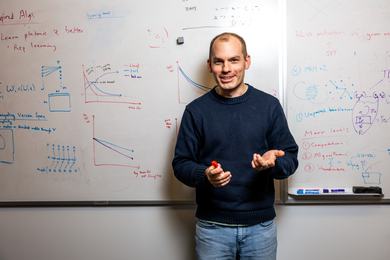How do you keep MIT innovative and strong while taking actions to reduce a serious budget deficit?
This is the challenge we face as we seek to reduce the gap between our income and expenses by $40 million over the next several years.
When we began this effort with the FY93 budget planning process, we set out a number of institutional objectives to help guide our decisions. When I say "our," I mean all those who are involved in program planning, whether on the academic or the administrative side of the house. The first of these objectives is to maintain MIT's position as the leading academic institution focused on science and technology. Other objectives include: maintaining merit-based admission and need-based financial aid for undergraduates, tempering the rate of tuition growth, enhancing the diversity of our community, fully supporting academic year salaries for faculty (rather than relying on "soft money" from grants and contracts), compensating our employees properly, and maintaining enough flexibility to take advantage of new ideas and opportunities advanced by the faculty.
Financially, our goal is to curb the rate at which our expenses grow, bringing this growth into line with the more modest growth in our revenues. Ironically, the only source of revenue over which we have direct control is tuition, and we are committed to holding down increases on that front as much as possible. Thus, achieving progress on our goal of reducing the operating gap by $40 million and in achieving our institutional objectives depends on reducing sharply the budgets in some areas, while providing significant new resources in others.
Some of the budget decisions in the past two years will illustrate some of the changes that have taken place. These have, generally, come about through discussions among the deans and affected faculty or administrative staff. Space here does not permit a complete accounting of all budget actions, but examples of reductions include:
- Closing of the supercomputer facility-about $150,000 per year.
- Elimination of offerings in dance-about $56,000 per year.
- Elimination of central funding for the Technology and Culture Seminar-about $35,000 per year.
- Elimination of the centrally funded travel program for faculty-about $225,000 per year.
- Elimination of the central budget for equipment purchases by departments-$700,000 per year.
- Elimination of five faculty positions in the Department of Physics (as they become open)-eventually about $350,000 per year.
- Elimination of about 10 other faculty positions across the Institute (as they become open)-about $700,000 per year.
- Consolidation and downsizing of purchasing functions-about $360,000 per year after the transition period.
- ������Reduction of central funds for the Sloan School budget over three years-$1,500,000 per year.
- Elimination of table service lunch at the Faculty Club-about $250,000 per year.
The sum of these actions alone is quite significant: a reduction in the annual budget of about $4 million. In some instances, actions have resulted in reduction in staffing, including in Information Systems and the Libraries (not included in the list above).
While we have made some significant budget reductions, we also have made some meaningful investments in line with the institutional objectives mentioned above. Examples of these investments include the following:
We have made major progress in fully supporting academic year faculty salaries (rather than relying on "soft money" from grants and contracts.) Over the past three years, the percentage of academic year faculty salaries supported by soft money has been reduced from about 14 percent to about 10 percent, at a cost of about $5.5 million annually.
In the School of Science, only the academic year salaries in the Departments of Biology and Brain and Cognitive Sciences are not fully "hardened" as we begin FY95. The School of Engineering has about 17 percent of its academic year salaries for faculty on soft money, and the FY95 budget will include another $250,000 for hardening salaries in that School.
We have won our case with the Department of Justice in connection with the antitrust lawsuit and we are committed to maintaining our need-based aid policy and meeting the full need of admitted undergraduates. The amount of general funds MIT spends on undergraduate financial aid (in addition to funds generated by the endowment for this purpose) has grown from $11.6 million in FY91 to an anticipated $16.5 million in FY94.
We have made progress in attracting more women and minority faculty to MIT and new recurring budget commitments in this arena total about $1,500,000 annually.
We have maintained salary increase programs in order to properly recognize the outstanding contributions of all those who work at MIT. This has accounted for a net increase of $8.4 million in general Institute funds for the current year.
We have invested in a number of new academic programs in order to respond to important needs. These include new resources for the Biology Department in connection with the new core biology requirement ($325,000 in annual costs) and for the Department of Electrical Engineering and Computer Science in connection with the new Master of Engineering five-year degree program ($450,000 in annual costs).
We have continued to enhance the computer resources available to students. This year, we brought the living groups onto the campus network for a one-time implementation cost of $500,000 and recurring annual operating costs of $570,000.
The Athena computing environment equipment renewal program has been increased from zero in FY91 to an annual amount of $1.6 million in FY95.
We are making progress in closing our operating gap by reducing the rate at which our expenses are growing, particularly in the administrative areas, where we are estimating an actual decrease for next year. A review of the current and recent budgets gives the picture. Remember, these are figures for general Institute funds, not research funds or indirect costs supported by outside research sponsors. "Academic" refers to those areas reporting to the Provost; "Administrative" refers to those areas reporting to the Senior Vice President.
Fiscal Year Academic Administrative
FY92 (budget) $168.5 million $121.4 million
FY93 (budget) $177.8 million $128.5 million
FY94 (budget) $186.3 million $129.8 million
FY95 (estimate) $189.3 million $127.9 million
The key to bringing our budget into balance while maintaining our ability to invest in new faculty-based initiatives is not simply to cut budgets across the board. Such actions would erode our strength and morale. We need to make programmatic decisions based on the long term strategic plans that are developed by each department and School. On the administrative side, we are beginning the process of "reengineering" a number of key support services. This work will involve designing services from the ground up, eliminating unnecessary or redundant work, improving service and substantially reducing costs. While the focus of reengineering is on administrative operations, everyone who is supported by these activities will be affected and our success in these efforts will depend on a spirit of goodwill and cooperation during this period of change.
A version of this article appeared in the April 27, 1994 issue of MIT Tech Talk (Volume 38, Number 30).





